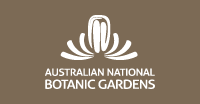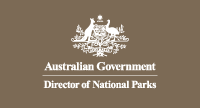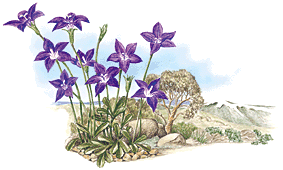 Royal
Bluebell
Royal
Bluebell
Wahlenbergia gloriosa
(plant family: Campanulaceae)
Floral Emblem of the Australian Capital Territory
The Royal Bluebell was announced as the floral emblem of the Australian Capital Territory on 26 May 1982 by the Hon. Michael Hodgman, the Minister for the Capital Territory.
This species was the unanimous recommendation of a committee chaired by Dr Robert Boden, then Director of the Australian National Botanic Gardens. Mr Max Gray and Professor Lindsay Pryor were invited to join the committee to provide botanical advice on local species to be evaluated as potential floral emblems, and Mrs Lorna Rudduck and Mr Derek Wrigley assessed the merits of each species for design purposes. Native occurrence in the Australian Capital Territory was the main criterion accepted by the committee but other desirable features sought in a ranked list of recommendations included horticultural merit and design potential, both in naturalistic and stylised representations.
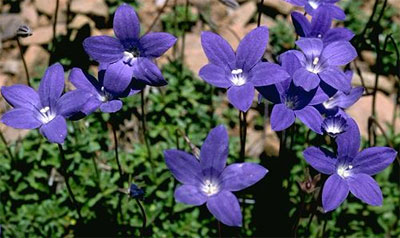 The
genus Wahlenbergia was proposed by Heinrich Schrader, a German botanist,
in honour of Georg Goran Wahlenberg (1780-1851), Professor of Botany at Uppsala,
Sweden, and described by Albrecht Roth in 1821. The species name gloriosa is Latin for 'superb' or 'glorious', a reference to superb qualities of a plant
worthy of cultivation.
The
genus Wahlenbergia was proposed by Heinrich Schrader, a German botanist,
in honour of Georg Goran Wahlenberg (1780-1851), Professor of Botany at Uppsala,
Sweden, and described by Albrecht Roth in 1821. The species name gloriosa is Latin for 'superb' or 'glorious', a reference to superb qualities of a plant
worthy of cultivation.
The genus Wahlenbergia occurs chiefly in South America, New Zealand and Australia. It belongs to the bluebell family, Campanulaceae, which is distributed mainly in temperate areas of the Northern hemisphere. The use of the common name 'bluebell' for Wahlenbergia species is somewhat confusing as many distantly related genera also share this descriptive common name.
Wahlenbergia gloriosa is a small perennial herb with oblong leaves about 2.5 cm long; the leaf margins are conspicuously waved. The violet blue* flowers are up to 2-3 cm in diameter and often appear to have a paler centre due to the light blue base of the petals combined with the purple style which ends in two white stigmas. The flowers may be erect or nodding and are carried on long slender stems.
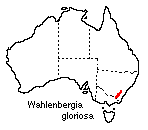 Royal
Bluebell occurs mainly in sub-alpine woodland in the Australian Capital Territory,
south-eastern New South Wales and Victoria. It is legally protected throughout
its occurrence in the wild.
Royal
Bluebell occurs mainly in sub-alpine woodland in the Australian Capital Territory,
south-eastern New South Wales and Victoria. It is legally protected throughout
its occurrence in the wild.
Royal Bluebell is a charming plant in cultivation. Propagation is possible from seeds, cuttings or root divisions. It is suitable for growing in sunny or semi-shaded positions in cool regions, as a ground cover, and in shallow pots or hanging baskets. Well-drained soils are necessary and these may be enriched by applications of humus. Established plants respond to applications of soluble fertiliser. Flowering extends from October to March. The flowers are short-lived when cut but potted specimens in flower are suitable for indoor decoration in brightly lit positions.
The announcement of the Royal Bluebell as the floral emblem brought the Australian Capital Territory to a position equal to that of the Australian States and the Northern Territory. Previously, in the absence of official territorial emblems, the armorial bearings granted to the city of Canberra tended to be used, either partly or wholly, by community groups and sporting representatives. Naturally Canberra's armorial bearings are related to its status as the seat of the Australian Parliament but two of the heraldic devices are also botanical in nature, The Rose of York, included at the base of the arms, commemorates the role of the Duke of York in the establishment of the seat of government at Canberra. The Eucalyptus tree, pictured on the mound behind the portcullis, is typically Australian and represents the growth and progress of Canberra and its development as a garden city.
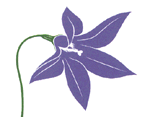 The
Royal Bluebell has been enthusiastically adopted by community groups and craftsmen
seeking a symbol of the Australian Capital Territory.
The
Royal Bluebell has been enthusiastically adopted by community groups and craftsmen
seeking a symbol of the Australian Capital Territory.
Both stylised and realistic designs have been used in screen-printed woven goods and stationery produced for local consumers and the tourist trade. The Royal Australian Mint produced a medallion in 1983, bearing the royal bluebell on the obverse side and a symbolic representation of the Mint on the reverse.
A postage stamp [illust] featuring Wahlenbergia gloriosa was issued on 25 August 1986, designed by Betty Conabere.
Download a line illustration by Marion Westmacott.©
Download copyright-free illustration by Fay Davies, suitable for childrens' colouring.
*Colour reference: R.H.S. Colour Chart (1966), Violet blue group 93C (Royal Horticultural Society, London).
Written by Anne Boden for a booklet published by AGPS for the ANBG in 1985.
![An Australian Government Initiative [logo]](/images/austgovt_brown_90px.gif)





